A Short History Of Japanese Literature
Beginnings
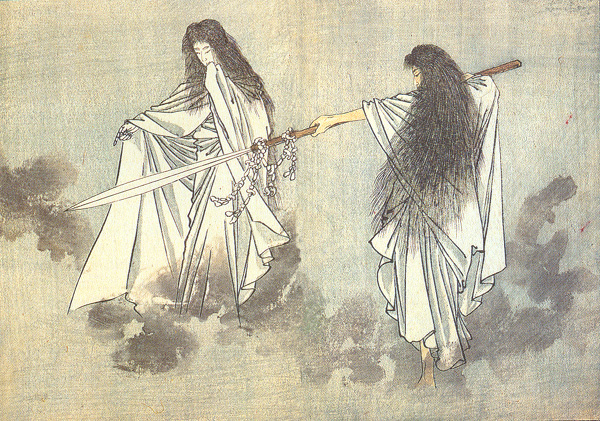
These are the great deities Izanagi and Izanami, the Sun Goddess and
goddess of the universe, who birthed the islands of Japan and Amaterasu.
Japanese literature traces its beginnings to oral traditions that were first recorded in written form in the early eighth century after a writing system was introduced from China. The Kojiki (Record of Ancient Matters) and Nihon shoki (Chronicle of Japan) were completed in 712 and 720, respectively, as government projects. The former is an anthology of myths, legends, and other stories, while the latter is a chronological record of history. The Fudoki (Records of Wind and Earth), compiled by provincial officials beginning in 713, describe the history, geography, products, and folklore of the various provinces.
The most brilliant literary product of this period was the Man'yoshu (Collection of Ten Thousand Leaves), an anthology of 4,500 poems composed by people ranging from unknown commoners to emperors and compiled around 759. Already emerging was a verse form made up of four lines with 31 syllables (5-7-5-7-7) known as tanka. In 905 the Kokin wakashu or Kokinshu (Collection of Poems from Ancient and Modern Times) was published as the first poetry anthology commissioned by an emperor; its preface paid high tribute to the vast possibilities of literature.
The Heian Period: 794 - 1185
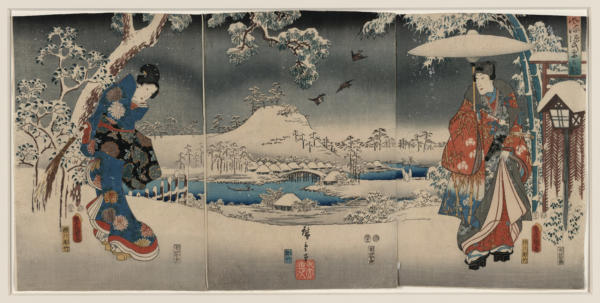
Artists lavishly illustrated scrolls depicting the story, making the story expensive.
Because of this, less well-off noblewomen dreamed about owning a copy.
Dring the Heian Period, the Japanese were fascinated with Chinese culture. The Imperial Court emulated Chinese fashion and customs while they pursued the arts. A noble was expected to be well-versed in literature, poetry, painting, dancing, calligraphy, and more. Noble men used the Chinese language in the same way that Medieval European nobles and priests used Latin. In Heian Japan, Women were not allowed to speak Chinese. The period expected women to remain separate from men. They would converse through fabric blinders dividing rooms. Genji shows how great the difference was between the genders by having characters fall in love with each other based on their handwriting.
Classical Japanese literature generally refers to literature produced during the Heian period, what some would consider a golden era of art and literature. Genji Monogatari (early eleventh century) by Murasaki Shikibu is considered the pre-eminent masterpiece of Heian fiction and an early example of a work of fiction in the form of a novel. Other important works of this period include the Kokin Wakashu (905), a waka-poetry anthology, and Makura no Soshi (990s), the latter written by Murasaki Shikibu's contemporary and rival, Sei Shonagon, as an essay about the life, loves, and pastimes of nobles in the Emperor's court.
The 10th century Japanese narrative, Taketori Monogatari, can be considered an early example of proto-science fiction. The protagonist of the story, Kaguya-hime, is a princess from the Moon who is sent to Earth for safety during a celestial war, and is found and raised by a bamboo cutter in Japan. She is later taken back to the Moon by her real extraterrestrial family. A manuscript illustration depicts a disc-shaped flying object similar to a flying saucer.
In this time the imperial court patronized the poets, most of whom were courtiers or ladies-in-waiting. Editing anthologies of poetry was a national pastime. Reflecting the aristocratic atmosphere, the poetry was elegant and sophisticated and expressed emotions in a rhetorical style.
The Kamakura-Muromachi Period: 1185 - 1600
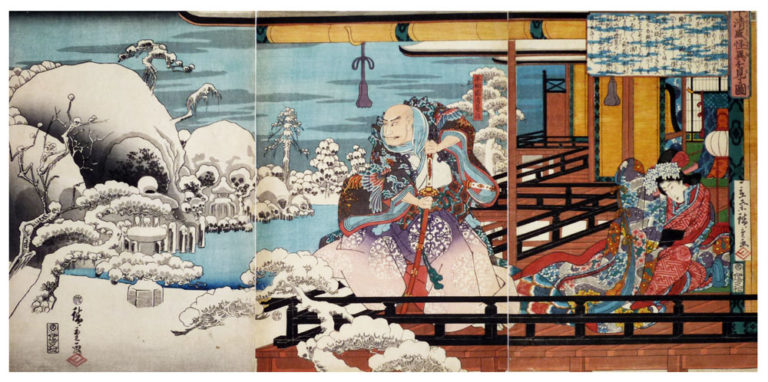
The central theme of the story is the Buddhist law of impermanence, especially the fleeting nature of fortune.
Above is a triptych of one scene in the story, “Illustration of Taira no Kiyomori’s vision of spectres” (1843)
In the latter half of the twelfth century warriors of the Taira clan (Heike) seized political power at the imperial court, virtually forming a new aristocracy. Heike Monogatari (The Tale of the Heike),which depicts the rise and fall of the Taira with the spotlight on their wars with the Minamoto clan (Genji), was completed in the first half of the thirteenth century [before 1219 ]. It is a grand epic deeply rooted in Buddhist ethics and filled with sorrow for those who perished, colorful descriptions of its varied characters, and stirring battle scenes. In former times the tale was narrated to the accompaniment of a Japanese lute. The Shin kokin wakashu (New Collection of Poems from Ancient and Modern Times), an anthology of poetry commissioned by retired Emperor Go-Toba, was also completed around this time [ca 1205 ?]; it is dedicated to the pursuit of a subtle, profound beauty far removed from the mundane reality of civil strife.
This period also produced literature by recluses, typified by Kamo no Chomei's Hojoki (An Account of My Hut) [1212] , which reflects on the uncertainty of existence, and Yoshida Kenko's Tsurezuregusa (Essays in Idleness) [ca 1330 ] , a work marked by penetrating reflections on life. Both works raise the question of spiritual salvation. Meanwhile, the profound thoughts and incisive logic of the Shobogenzo (Treasury of the True Dharma Eye) [before 1237 ] , one of the first Buddhist texts written in Japanese rather than Chinese, marked a major development in Zen thought. The Taiheiki (Chronicle of the Great Peace), depicting the 50 years from 1318 to 1367 when two rival imperial courts struggled for power, is a valuable historical record, while the Noh plays perfected by Kan'ami and his son Zeami are of great literary value. Zeami's Fushi kaden (The Transmission of the Flower of Acting Style) [1400] is a brilliant essay on dramatic art.
Medieval Japanese Literature is marked by the strong influence of Zen Buddhism, where characters are priests, travelers, or ascetic poets. Also during this period, Japan experienced many civil wars which led to the development of a warrior class, and subsequent war tales, histories, and related stories. Work from this period is notable for its insights into life and death, simple lifestyles, and redemption through killing.
Other notable genres in this period were Renga, or linked verse, and Noh theater. Both were rapidly developed in the middle of the 14th century, the early Muromachi period.
The Edo Period: 1600 - 1868
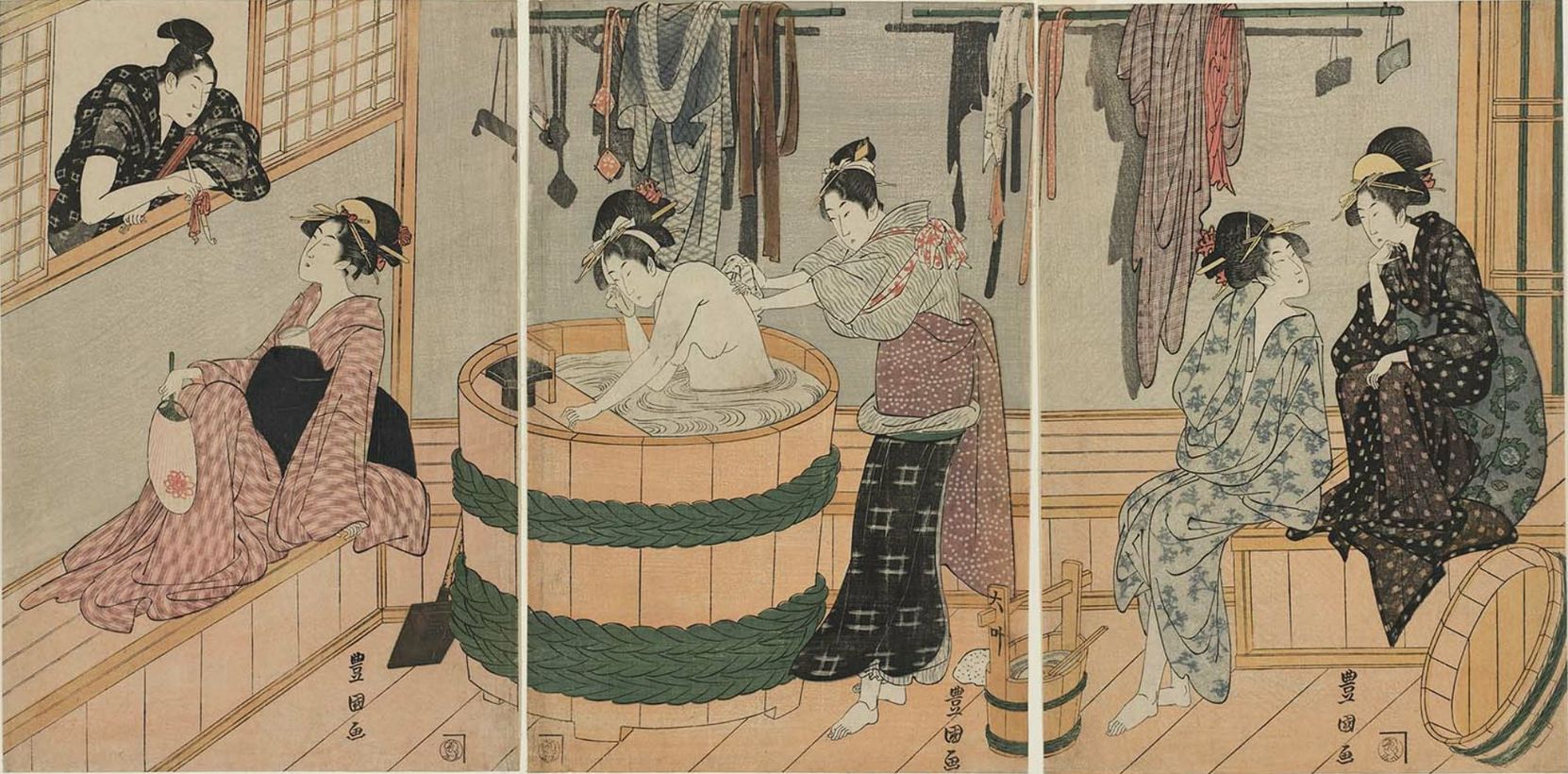
to explore things like bathhouses, the theater, and reading. The image above is a ukiyo-e, or "Image of the floating world,"
by Toyokuni, titled "The Bathhouse."
Around this time the function of literature as a means of social intercourse broadened. Composing Renga (successive linked verses by several people forming a long poem) became a favorite pastime, and this gave birth to Haikai (a sort of comedic Renga) in the sixteenth century. It was the renowned seventeenth century poet Matsuo Basho who perfected a new condensed poetic form of 17 syllables (5-7-5) known as Haiku, an embodiment of elegant simplicity and tranquility.
In the Genroku era (1688-1704) city-dwelling artisans and merchants became the main supporters of literature, and professional artists began to appear. Two giants emerged in the field of prose: Ihara Saikaku, who realistically portrayed the life of Osaka merchants, and Chikamatsu Monzaemon, who wrote Joruri, a form of storytelling involving chanted lines, and Kabuki plays. These writers brought about a great flowering of literature. Later Yosa Buson composed superb Haiku depicting nature, while fiction writer Ueda Akinari produced a collection of gothic stories called Ugetsu monogatari (Tales of Moonlight and Rain) [1776] .
Literature during this time was written during the largely peaceful Tokugawa Period (commonly referred to as the Edo Period). Due in large part to the rise of the working and middle classes in the new capital of Edo (modern Tokyo), forms of popular drama developed which would later evolve into Kabuki.
Many genres of literature made their debut during the Edo Period, helped by a rising literacy rate among the growing population of townspeople, as well as the development of lending libraries. Although there was a minor Western influence trickling into the country from the Dutch settlement at Nagasaki, it was the importation of Chinese vernacular fiction that proved the greatest outside influence on the development of Early Modern Japanese fiction. Ihara Saikaku might be said to have given birth to the modern consciousness of the novel in Japan, mixing vernacular dialogue into his humorous and cautionary tales of the pleasure quarters. Jippensha Ikku wrote Tokaidochu Hizakurige, which is a mix of travelogue and comedy. Tsuga Teisho, Takebe Ayatari, and Okajima Kanzan were instrumental in developing the Yomihon, which were historical romances almost entirely in prose, influenced by Chinese vernacular novels such as Three Kingdoms and Shui hu zhuan. Two Yomihon masterpieces were written by Ueda Akinari: Ugetsu monogatari and Harusame monogatari. Kyokutei Bakin wrote the extremely popular fantasy/historical romance Nanso Satomi Hakkenden in addition to other Yomihon. Santo Kyoden wrote Yomihon mostly set in the gay quarters until the Kansei edicts banned such works, and he turned to comedic Kibyoshi. Genres included horror, crime stories, morality stories, comedy, and pornography -- often accompanied by colorful woodcut prints.
Nevertheless, in the Tokugawa, as in earlier periods, scholarly work continued to be published in Chinese, which was the language of the learned much as Latin was in Europe.
The Meiji Period: 1868 - 1945
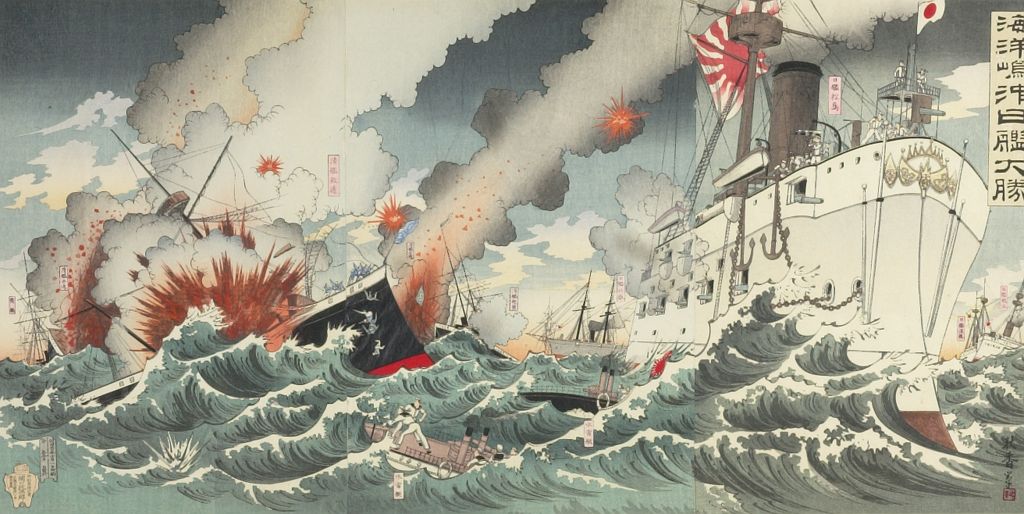
The Meiji period marks the re-opening of Japan to the West, and a period of rapid industrialization. The introduction of European literature brought free verse into the poetic repertoire; it became widely used for longer works embodying new intellectual themes. Young Japanese prose writers and dramatists struggled with a whole galaxy of new ideas and artistic schools, but novelists were the first to successfully assimilate some of these concepts.
In the early Meiji period (1868–1880s), Fukuzawa Yukichi and Water Margin authored Enlightenment literature, while pre-modern popular books depicted the quickly changing country. Then Realism was brought in by Tsubouchi Shoyo and Futabatei Shimei in the mid-Meiji (late 1880s - early 1890s) while the Classicism of Ozaki Koyo, Yamada Bimyo and Koda Rohan gained popularity. Ichiyo Higuchi, a rare woman writer in this era, wrote short stories on powerless women of this age in a simple style in between literary and colloquial. Kyoka Izumi, a favored disciple of Ozaki, pursued a flowing and elegant style and wrote early novels such as The Operating Room (1895) in literary style and later ones including The Holy Man of Mount Koya (1900) in colloquial Japanese.
Romanticism was brought in by Mori Ogai with his anthology of translated poems (1889) and carried to its height by Toson Shimazaki etc. and magazines Myojo and Bungaku-kai in early 1900s. Mori also wrote some modern novels including The Dancing Girl (1890), Wild Geese (1911), then later wrote historical novels. Natsume Soseki, who is often compared with Mori Ogai, wrote I Am a Cat (1905) with humor and satire, then depicted fresh and pure youth in Botchan (1906) and Sanshirô (1908). He eventually pursued transcendence of human emotions and egoism in his later works including Kokoro (1914) his last and unfinished novel Light and darkness (1916).
Shimazaki shifted from Romanticism to Naturalism which was established with his The Broken Commandment (1906) and Katai Tayama's Futon (1907). Naturalism hatched the "I Novel" (Watakushi-shôsetu) that describes the authors themselves and depicts their own mental states. Neo-romanticism came out of anti-naturalism and was led by Kafu Nagai, Jun'ichiro Tanizaki, Kotaro Takamura, Hakushu Kitahara and so on in the early 1910s. Saneatsu Mushanokoji, Naoya Shiga and others founded a magazine Shirakaba in 1910. They shared a common characteristic, Humanism. Shiga's style was autobiographical and depicted states of his mind and sometimes classified as "I Novel" in this sense. Ryunosuke Akutagawa, who was highly praised by Soseki, wrote short stories including Rashomon (1915) with an intellectual and analytic attitude, and represented Neo-realism in the mid 1910s.
During the 1920s and early 1930s the proletarian literary movement, comprising such writers as Takiji Kobayashi, Denji Kuroshima, Yuriko Miyamoto, and Ineko Sata produced a politically radical literature depicting the harsh lives of workers, peasants, women, and other downtrodden members of society, and their struggles for change.
War-time Japan saw the début of several authors best known for the beauty of their language and their tales of love and sensuality, notably Jun'ichiro Tanizaki and Japan's first winner of the Nobel Prize for Literature, Yasunari Kawabata, a master of psychological fiction. Ashihei Hino wrote lyrical bestsellers glorifying the war, while Tatsuzo Ishikawa attempted to publish a disturbingly realistic account of the advance on Nanjing. Writers who opposed the war include Denji Kuroshima, Mitsuharu Kaneko, Hideo Oguma, and Jun Ishikawa.
The Postwar Period: 1945 - Present
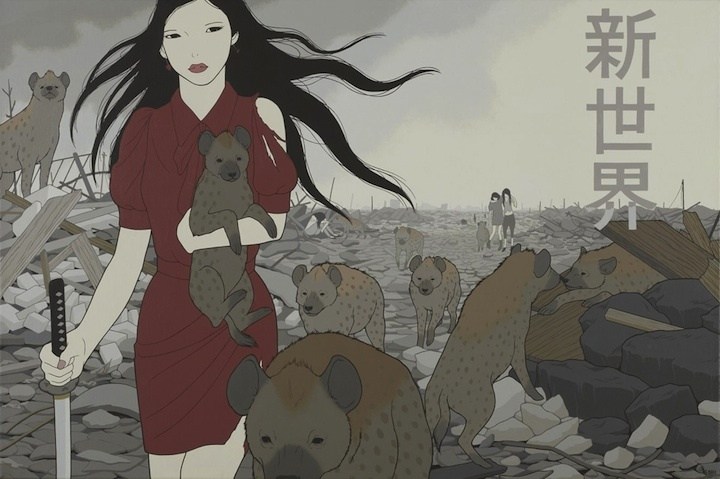
Inspired by Japan’s suffering after World War II and its successful recovery from devastation,
Kayukawa creates a message of hope.
World War II, and Japan's defeat, deeply influenced Japanese literature. Many authors wrote stories of disaffection, loss of purpose, and the coping with defeat. Osamu Dazai's novel The Setting Sun tells of a soldier returning from Manchukuo. Shohei Ooka won the Yomiuri Prize for his novel Fires on the Plain about a Japanese deserter going mad in the Philippine jungle. Yukio Mishima, well known for both his nihilistic writing and his controversial suicide by seppuku, began writing in the post-war period. Nobuo Kojima's short story "The American School" portrays a group of Japanese teachers of English who, in the immediate aftermath of the war, deal with the American occupation in varying ways.
Prominent writers of the 1970s and 1980s were identified with intellectual and moral issues in their attempts to raise social and political consciousness. One of them, Kenzaburo Oe wrote his best-known work, A Personal Matter in 1964 and became Japan's second winner of the Nobel Prize for Literature.
Although modern Japanese writers covered a wide variety of subjects, one particularly Japanese approach stressed their subjects' inner lives, widening the earlier novel's preoccupation with the narrator's consciousness. In Japanese fiction, plot development and action have often been of secondary interest to emotional issues. In keeping with the general trend toward reaffirming national characteristics, many old themes re-emerged, and some authors turned consciously to the past. Strikingly, Buddhist attitudes about the importance of knowing oneself and the poignant impermanence of things formed an undercurrent to sharp social criticism of this material age. There was a growing emphasis on women's roles, the Japanese persona in the modern world, and the malaise of common people lost in the complexities of urban culture.
Popular fiction, non-fiction, and children's literature all flourished in urban Japan in the 1980s. Many popular works fell between "pure literature" and pulp novels, including all sorts of historical serials, information-packed docudramas, science fiction, mysteries, detective fiction, business stories, war journals, and animal stories. Non-fiction covered everything from crime to politics. Although factual journalism predominated, many of these works were interpretive, reflecting a high degree of individualism. Children's works re-emerged in the 1950s, and the newer entrants into this field, many of them younger women, brought new vitality to it in the 1980s.
Manga (comic books) have penetrated almost every sector of the popular market. They include virtually every field of human interest, such as a multi volume high-school history of Japan and, for the adult market, a manga introduction to economics, and pornography. Manga represented between 20 and 30 percent of annual publications at the end of the 1980s, in sales of some ¥400 billion per year.